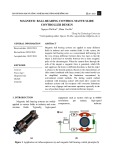
IEEE TRANSACTIONS
ON
AUTOMATIC
CONTROL,
VOL.
AC-12,
NO.
6,
DECEMBER
1967
651
Decoupling in
the
Design and Synthesis
of
Multivariable Control Systems
Absfracf-Necessary and sdicient conditions far the "decou-
pling" of an m-input, m-output time-invariant linear system using
state variable feedback are determined. Given
a
system which satis-
fies these conditions, i.e., which can be decoupled by state variable
feedback, the class of
all
feedback matrices which decouple the
system
is
characterized. The characterization of
@
is used to deter-
mine the number of closed-loop poles which can be specified for the
decoupled system and to develop
a
synthesis technique for the real-
ization
of
desired closed-loop pole configurations. Transfer matrix
consequences
of
decoupling are examined and practical implications
discussed through numerical examples.
I.
INTRODIJCTION
HE DEVELOPMENT of techniques for the
design of multivariable control systems is of con-
siderable practical importance.
A
particular de-
sign approach involves the use of feedback to achieve
closed-loop control system stability. In conjunction
with this approach, it is often of interest to know
whether or not it is possible to have inputs control out-
puts independently, Le.,
a
single input influences
a
single output. This is,
in
heuristic terms, the problem
of
decoupling.
The problem of decoupling
a
time-invariant linear
system using state variable feedback and the relation of
this problem to control system design have been dis-
cussed by several authors.
[11--[31
hiorgan['] considered
the question of decoupling for systems n-hose state
equations had a somewhat special form. His main re-
sult,
which is
a
special case of the main theorem of this
paper, was the following: the time-invariant linear
system
x=Ax+Bu
y
=
cx
can be decoupled if the matrix
CB
is nonsingular.
Rekasius[*] extended Morgan's result 'and outlined an
essentially trial-and-error procedure for specifying
a
certain number of the system's poles while decoupling
the system. Xeither IIorgan nor Rekasius gave a clear
of
manuscript received March 29, 196;. First part revised April 19,
First part
of
manuscript received Sovember
28,
1966; second part
1967; first and second parts combined and revised
July
14, 1967.
This research was supported in part
by
the Air Force Office
of
sci-
entific Research under
AFOSR
Grant 693-67 and in part by
N.-2S.I.
P.
L.
Falb is
with the Div.
of
Applied Mathematics,
Brown
University, Providence, R.
I.,
and
KASd
Electronics Research
Center, Cambridge,
Mass.
IV.
A.
ITolovich
is
with
NASA
Electronics Research Center,
Cambridge, Mass.
proof of sufficiency, and they did not consider the ques-
tion of necessity.
In this paper,
a
necessary and sufficient condition for
decoupling will be given; a characterization of the class
of feedback matrices which decouple a system u-ill be
determined; the number of closed-loop poles which can
be specified while decoupling will also be determined;
and a synthesis procedure for obtaining desired closed-
loop pole configurations will be developed. In line n-ith
these objectives, the remainder of this paper
is
divided
into the following sections:
11.
111.
11'.
v.
VI.
VII.
Definitions
Main Theorem
Class
of Decoupling 3Iatrices
A
Synthesis Procedure
Decoupling by Output Feedback
A
Practical Example.
In Section I1 precise definitions of
state
variable feed-
back and decoupling are given. Then the basic necessary
and sufficient condition for decoupling is proved in
Section 111. Using the main theorem, a description of all
the decoupling matrices
is
presented in Section 117.
Next, in Section
V
the questions of synthesis and closed-
loop pole placement are examined. In Section VI state
variable feedback is replaced by output feedback and
the relevant theory developed. The practical potential
of the methods
is
indicated in the discussion of
a
VjSTOL stability augmentation system in Section VII.
11.
DEFIXITIONS
Consider the time-invariant linear system
X=Ax+Bu
y
=
cx
(1)
where
x
is
an
n
vector called the state,
u
an
m
vector
called the control (or input),
y
an
m
vector called the
output, and
A,
B,
and
C
are
n
Xn,
nXm,
and
YIZ
Xn
matrices, respectively. It is assumed that
nzsn.
If
F
is
an
mXn
matrix and
G
a nonsingular
nzXm
matrix, then
the substitution of
u
=
Fx
4-
Go
(2)
where represents the new
m
vector control (Fig.
I),
into
(1)
shall
be
called
linear stafe variablefeedback.
Let
dl,
d?,
.
-
.
,
dm
be given by
Authorized licensed use limited to: Rensselaer Polytechnic Institute. Downloaded on October 9, 2009 at 00:34 from IEEE Xplore. Restrictions apply.

652
IEEE TRANSACTIONS ON AUTOMATIC
CONTROL,
DECEMBER
1967
Y
-
I
'-=-I
E
I
Fig.
1.
&Idtivariable
feedback
system.
or
a;
=
tz
-
1
if
CiAjB
=
0
for
allj
x-here
Ci
denotes the ith row of
C.
Then, a simple calcu-
lation shows that
where
0
is
a
zero matrix consistent with the order of
Li{
F,
G).
If
Eij
denotes the
n2X.m
matrix with
1
as
ijth entry and zeros elsewhere, then
E&
is an
mXn
matrix xith the ith row identical
to
the ith row of and
all other rows zero. The matrix
EiiQ
will be denoted by
Qi.
The following definition can
no\\-
be made.
The matrices
F
and
G,
with
G
nonsingular,
decouple
the system
(1)
if
I:=O
=
tr (Li(F,
GIG'),
. ,
ill.
(1
1)
for
i=
I,
.
.
.
,
m..
Application of the state variable feed- Note that this
is
a
precise definition that does not
back
(2)
and repeated differentiation
yield the relations
Yi
=
C~X
=
C;(A
+
BF)OX
yi
=
C~AX
=
Ci(A
+
BF)x
together with
(4)
involve vague statements about inputs controlling
outputs independently.
111.
AIAIS
THEOREM
IVith the definitions of Section 11, it is
no\v
possible
to state and prove
a
theorem which gives
a
necessary
and sufficient condition for decoupling.
\\-here the
&(F)
are scalars depending on
F.
Thus,
x
can
be eliminated from the final relation of
(5)
to
give
n-1
3,
.(n)
-
pk(F)yick)
=
tr
(Li{F,
GIB)
(7)
k=O
(12)
Then there
is
a
pair of matrices
F
and
G
which decouple
the system
(1)
if and only if
det
B*
#
0
(13)
Le.,
if
and only
if
B*
is
nonsingular.
is
claimed that the pair
Proof:
Suppose first that
B*
is
nonsingular. Then it
F*
=
-
B*-lA*
where tr
(.)
denotes the trace of
a
matrix,
P
is the
mX?z
matrix given
by
G*
=
B*-l
\\-here
and
Li
[
F,
G
]
is the
n
Xm
matrix given
by
CIAdl+l
A*=[
]
C,Adm+l
Ci[(A
+
BF)di]BG
0
J
Authorized licensed use limited to: Rensselaer Polytechnic Institute. Downloaded on October 9, 2009 at 00:34 from IEEE Xplore. Restrictions apply.

FALB
AND WOLOVICH: DECOUPLING IN MULTIVARIABLE CONTROL SYSTEMS
653
decouples (1). In view of
(4),
Ci(A
+
BF*)di+l
=
C.Adi+l
+
C.Ad’ lBF*.
(16)
But
CiAdiB
is simply the ith row of
B*
and
so
it follows
that
CAdiBF*
=
-
Bi*B*-lA*
=
-
Ai*
=
-
CiAdi+l
(17)
where
Bi*
and
Ai*
are the ith rows of
B*
and
A*,
respec-
tively. Thus
Ci(A
+
BF*)di+k
=
0
(18)
for any positive integer
k.
In a similar way,
it
follows
that
Ci(A
+
BF*)diBB*-l
=
B .*B*-l
(19)
and hence that
1
’
Bi*B*-l
lo
However,
Bi*B*-l
=ei,
a
row vector with
1
in the ith
place and zeros elsewhere and
so
tr
(L~(F*,
G*}Q)
=
-~~i+l(~)W~-~~*+~(~)Wi(l)-
. . .
+
Wi(n-di-l)
(21)
=
tr
(Li{
F*, G*}ai)
PO.
(22)
In other words,
F*
and
G*
decouple (1).
which decouple (1). Then it follows from
(4)
that
Now
suppose that there is a pair
of
matrices
F, G
Ci(A
+
BF)diBG
=
Bi*G,
i
=
1,
.
* *
,
m.
(23)
Since
CiAiB
=
0
for all
j
would imply that
tr
(Li{
F, G}
SL)
=
0, which would contradict the fact that
F
and
G
decouple
(l),
it is clear that
Bi*#O
for
Since
(10)
is
satisfied,
it
follows that
Bi*G
is
an
m
row
vector of the form
airi
with
ai#O
[otherwise there
would be
uj(;:),
j#i,
terms in tr
(Li{
F, G}SL)].
Thus,
i=l,.
.
.
,
m.
As G
is
nonsingular,
Bi*G#O
for all
i.
B*G
=
where
m
TJI
ai
#
0.
i=
1
Hence,
B*
is nonsingular since
G
is.
The theorem just proved shows that
B*
is of para-
mount importance in the decoupling of (1) by state
variable feedback. The basis for the choice of
F*
andG*
in the proof of the theorem is the following observation.
Since
(5)
implies that
yi(di+l)
=
Ci(A + BF)ds+l~
+
CiAd’BGw
(25)
u-hich may also be written in the form
y*
=
(A”
+
B*F)x
+
B*Go
(26)
where
y*
is the
m
vector with components
yi(&+l),
it
is
clear
that
the
choice
F
=
F*
and
G
=
G*
leads to
y*
=
0
(27)
or, equivalently, to
jri(di+l)
=
uj.
(28)
Caution: Equation
(28)
does not represent the de-
coupled system since, in general,
it
involves the cancel-
lation of zeros. The equations of the decoupled system
are given by
(10)
or
in state form as
x
=
(A
+
BF)x
+
BGo
y
=
cx
where
F, G
are
a
decoupling pair.
It has now been established that the nonsingularity
of
B*
is
a
necessary and sufficient condition for the
existence of
a
pair of matrices
F, G
which decouple
(1).
In the next section, the set of all pairs
F, G
which de-
couple
(1)
will be characterized under the assumption
that
B*
is
nonsingular. This characterization leads
to
“answers” to the following two questions:
1) the synthesis question, namely: how many closed-
loop poles can be specified for the decoupled sys-
tem, how arbitrarily can they be specified, and
how easily can an algorithm for specifying these
poles be developed?
2)
the output feedback question, namely: when can
feedback of the form
u=Hy+Gw
decouple
(l)?
IV.
CLASS
OF
DECOUPLIKG
RIATRICES
Let
F
be an mxn matrix and let
G
be
a
nonsingular
m
Xm matrix. Under the assumption that (1) can be de-
coupled, necessary and sufficient conditions for
F, G
to
be a decoupling pair are determined in this section.
These conditions turn out
to
be independent of
G
so
that it will make sense to speak of the class
C€J
of matrices
F
which “decouple”
(1).
Definition
Let
Q(F)
be the nXm matrix given by
Ci(A
+
BF)n-’B
Ci(A
+
BF)n-2B
Qi(F)
=
[
\
1,
i
=
1,.
-
.
,nz
(29)
where
0
is a zero matrix consistent with the order
of
Qi(F).
Let
Pi(F)
be the nXn matrix given by
Ci(A
+
BF)d’B
Authorized licensed use limited to: Rensselaer Polytechnic Institute. Downloaded on October 9, 2009 at 00:34 from IEEE Xplore. Restrictions apply.

634
IEEE TRANSACTIONS ON AUTOMATIC CONTROL, DECEMBER
1967
where the
&(F)
are the coefficients of the characteristic
polynomial of
A+BF,
i.e., tr
(L'(F,
B*-']Q)
=
tr
(P~(F)Q~(F)B*-~P)
n-
1
=
tr
(Pi(F)Qi(F)B*-'Pi)
#
0
(39)
(A
+
BF)"
=
pk(F)(A
+
BFIk
(3
1)
0
and
so
the pair
F,
B*-l
decouples
(1).
and
I
is an identity matrix consistent with the order
of
Pi(F).
Corollary
1
Since
P'(F)
is nonsingular, it follon-s that the rank If the pair
F,
G
decouples
(l),
then there
is
adiagonal
of
Pi(F)Qi(F)
is the same as the rank of
Qi(F).
Kote matrix
A
such that
G=AB*-l.
also that
Proof:
If
F,
G
decoupless
(l),
then
Qi(F)
is given by
~,
Li{F,
G}
=
Pi(F)Qi(F)G
(3
2)
(37)
and
where
Li
{
F,
G
}
is defined by
(9).
Thus
I I
xis+
I
I
I1
I1
rank
[L'{F,
GI]
=
rank [Qi(F)],
i
=
1,
.
-
I
'?Z
(33)
Qi(F)G
=
0
1
.
.I
"y
1
.
.
.I
01;
Xi#(),
(40)
since
G
is nonsingular. In view of the definition
of
de-
l
xi
l
coupling, the follou-ing theorem can be established.
Theorem
2
It follo\vs that B*G=diag
[X1,
. .
,
X.],
and the cod-
is one for
all
i;
conversely, if the rank
of
Qi(F)
is one for
all
i
and if
B*
is nonsingular, then the pair
F,
E*-'
Corollary
2
decouples the system
(1).
I
I
II
I
101
I
If the pair
F, G
decouples
(l),
then the rank of
Qi(F)
1aV is established.
Proof:
Suppose first that
F,
G
decouple
(1).
Then matrix
~
such
that
If the pair
F,
G
decouples
(l),
then there
is
a diagonal
tr
(L~{F,
G]Q)
=
tr
(L~(F,
G)Q'>
z
o
(34)
FB
=
B*-l{
,,A**
-
A*}
B
(41)
for all
i
where
a
is the
mXlz
matrix given by where
A**
and
A*
are given
by
p
=[
I
II
I
.
.
.j
"(n-1)
.
(35)
CIA''
I
II
1
A**
=
[ ]
,
A*
=
A**A.
(42)
Since
P
is arbitrary, the ith column of
Li(F,
G}
is
a
C,AL
nonzero vector, while every other column of
Li
{
F,
G
}
is
the zero vector. It
follows
that
Li(
F,
G}
has
rank
one
Proof:
The corollary
is
an immediate consequence of
and hence, by
(33),
that rank
[Qi(F)]
=
1.
the relations
B*
is nonsingular. Since
Kow
suppose that rank
[Qi(F)]
=
1
for all
i
and that
Ci(A
+
BF)"+'
=
CiAdiB
+
CiAdi+'BFB
(43)
Ci(A
+
BF)"+'
=
riCi(A
+
BF)'iB.
(44)
Ci(A
+
BF)d'B
=
CiA'iB
=
Bi*
#
0
(3
6)
In
summary, thus far
it
has been shown that the non-
by the definition of di, \There
&*
is the ith
of
B*,
of
is
a
necessary
and sufficient
condition
it follows that for the existence of a decoupling pair
F,
G.
Furthermore,
the set
of
all pairs
F, G
which decouple
(1)
consists of
matrices
F
such that rank [Qi(F)]
=
1
for all
i,
and
G
(35)
such that
G=AB*-l,
where
A
is diagonal and non-
singular. In order to clarify these points, an example
will now be presented.
Authorized licensed use limited to: Rensselaer Polytechnic Institute. Downloaded on October 9, 2009 at 00:34 from IEEE Xplore. Restrictions apply.

FALB
iWD
WOLOVICH: DECOUPLING IN MULTIVARIABLE CONTROL
SYSTEMS
655
Example
1
Let
110
A=[::
:I,
.-[d
b],
=
[o
0
11.
100
Then
B*
=
['IB
]
=
[
'1.
C2AB
-1
1
Thus,
B*
is nonsingular and the system can be de-
coupled. The set
@
of all
F
which decouple the system
(45)
can
now
be obtained by determining all
2x3
matrices
F
such that rank
[Qi(F)]
=
1.
In
this example,
this implies that the elements
of
SP
must be
of
the form
V.
A
STXTHESIS
PROCEDURE
Theorem
2
does provide
a
procedure for determining
a,
the class of
all
feedback matrices
F
which decouple
(1).
However, the direct application of the condition,
rank
[Qi(F)]
=
1
for all
i,
results
only
in constraints
being placed
on
certain of the
nzn
parameters of
F.
What
is
still required
is
a procedure for specifying closed-loop
system poles while simultaneously decoupling
(1)
using
an
appropriate
FE@.
In this light,
a
synthesis pro-
cedure will
now
be presented for directly obtaining a
feedback matrix
Fe@
whose parameters are
so
deter-
mined as to yield
a
desired closed-loop pole structure.
In particular, suppose that
Mk,
R
=0,
1,
. .
.
,
6
are
given
mXm
matrices. Then the choice
6
F
=
B*-'[
M&Ak
-
A*]
which indicates that
F
and
G
decouple
(1)
and that
m+
cy=l
di
of
the closed-loop poles can be varied by
varying the
Mk.
In this light, consider the following
example.
Example
2
Let
A=
-010000-
00
0
0-1
0
0
0
10
001000
-0
1
00
000001
00
-0
0
0
0
0
0-
,1
0
000010'
B=
N
Om
B*
=
[y
A],
A*=[
010000
000000
Since
B*
is nonsingular, the system can be decoupled.
Setting, for example,
one obtains, using
(29),
the decoupled system
Note that in this case
det
(SI
-
A
-
BF)
=
s2(s
+
l)(s3
-
s?
-
s
-
1)
where the poles representing
s(s3-ss%
-s-
1)
have been
specified by the choice
of
the
Mk.
Other choices
of
the
Mk
would lead
to
other closed-loop pole configurations.
Therefore,
if
B*
is
nonsingular,
m+
d,
of the sys-
tem's closed-loop poles can be arbitrarily specified
(&+l
at
a
time) while simultaneously decoupling the
system using the synthesis procedure. The synthesis
question
is,
therefore, partially resolved, although some
points still require clarification. In particular, it will be
shown that
m+
zz,
di
can never exceed
n,
the number
of system poles, and that it is sometimes possible to
specify more than
m+xy-l
di
poles while simultaneously
decoupling the system.
Authorized licensed use limited to: Rensselaer Polytechnic Institute. Downloaded on October 9, 2009 at 00:34 from IEEE Xplore. Restrictions apply.












![Đề cương đề tài nghiên cứu khoa học [chuẩn nhất/mới nhất]](https://cdn.tailieu.vn/images/document/thumbnail/2025/20251117/duong297/135x160/26111763433948.jpg)













